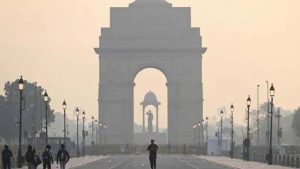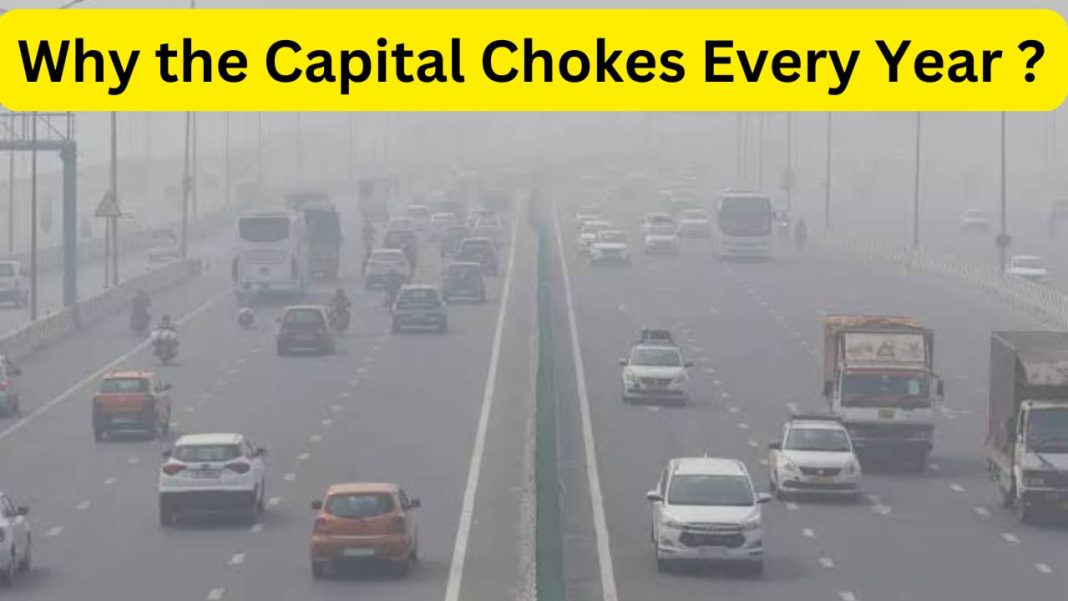Digital News Desk:
Every winter, Delhi, India’s capital, faces a dramatic surge in air pollution levels, turning the city into a virtual gas chamber. The air quality deteriorates so badly that it is often hazardous to residents’ health, forcing schools to close and prompting emergency health advisories. Several factors contribute to Delhi’s annual air pollution crisis during winter, including a combination of meteorological, geographical, and human-induced elements. Here’s a breakdown of why this happens.
- Stubble Burning in Neighboring States
One of the most significant contributors to Delhi’s winter air pollution is stubble burning in the neighboring agricultural states of Punjab and Haryana. After the harvest season, farmers burn crop residues (or stubble) from paddy fields to prepare for the next sowing cycle. This traditional but harmful practice releases vast amounts of particulate matter (PM2.5 and PM10) and harmful gases into the atmosphere.
These emissions from stubble burning drift toward Delhi due to favorable wind patterns. The capital city, already struggling with local pollution sources, finds its air quality plummeting further due to this seasonal activity. Despite efforts by the government to discourage stubble burning by offering financial incentives and alternative methods of clearing the fields, the practice continues to affect Delhi’s air quality significantly during the months of October and November.
- Meteorological Factors: Cooler Temperatures and Calm Winds
Delhi’s geography and winter weather patterns also play a significant role in worsening air pollution. As winter sets in, the temperature drops and wind speeds decrease, causing pollutants to become trapped closer to the ground. This phenomenon, known as temperature inversion, occurs when a layer of warm air settles above cooler air near the ground, preventing pollutants from dispersing into the upper atmosphere.
Without strong winds to disperse the airborne pollutants, particles from vehicles, industries, construction, and crop burning accumulate in the lower atmosphere, resulting in a thick smog over the city. This “air stagnation” can persist for days or even weeks, making the pollution levels hazardous for residents.

- Vehicular Emissions
Delhi has one of the highest numbers of registered vehicles in India, with millions of cars, buses, trucks, and two-wheelers plying its roads daily. These vehicles, particularly older models and diesel-powered ones, emit a high amount of nitrogen oxides (NOx), carbon monoxide (CO), and particulate matter, which are key contributors to air pollution.
Despite government efforts to reduce vehicular pollution, such as promoting electric vehicles (EVs), implementing odd-even traffic schemes, and encouraging the use of public transport, the sheer volume of vehicles on Delhi’s roads continues to pose a significant challenge. Traffic jams, idling engines, and outdated technology all exacerbate the problem, particularly in the winter when pollution levels are already elevated.
- Construction and Industrial Emissions
Delhi’s rapid urbanization and infrastructure development have also been major contributors to air pollution. Construction activities generate large amounts of dust, which adds to the particulate matter in the air. Additionally, small and medium-scale industries in and around Delhi, many of which rely on coal and other polluting fuels, contribute significantly to the emissions.
Though the government often imposes temporary bans on construction during peak pollution periods, these measures are not always strictly enforced, and illegal construction activities continue to release dust and other pollutants into the air.
- Use of Firecrackers
Another factor that worsens air quality in Delhi is the widespread use of firecrackers during festivals like Diwali, which typically falls in the autumn or early winter. Despite repeated bans and public awareness campaigns, many residents continue to light firecrackers, releasing a cocktail of toxic chemicals and particulate matter into the already polluted air.
The situation becomes especially critical when Diwali coincides with the stubble burning season, as both events contribute to a dramatic spike in pollution levels, with air quality indices (AQI) often crossing hazardous levels.
- Indoor Pollution and Biomass Burning
Lastly, many households in the outskirts of Delhi and nearby rural areas still rely on biomass fuels like wood and cow dung for cooking and heating. These practices release large amounts of fine particulate matter into the air, contributing to both indoor and outdoor air pollution.
Although cleaner alternatives like LPG (liquefied petroleum gas) and electric heating are being promoted, the transition has been slow, and the use of biomass continues to add to the overall pollution levels during the colder months.
You May Also Read: Kumbh Mela: History, Importance, Major Sites and Spiritual Significance




